Umbilical
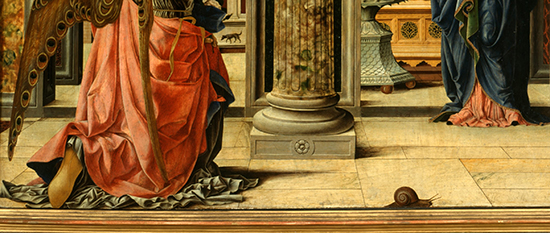
—...merely inconspicuous—
– Annunciation (detail)
Francesco del Cossa
Let us theorise that for each earthly city we are able to calculate a point where any one quality of that city – viz. its interiorness, its antiquity, its stability, &etc. – slides suddenly toward the antipodes of that quality, towards, respectively, an exteriority, a newness, a rank and invigorating chaos. And let us further theorise that there must be an ideal intersection of those axes, somewhere in space-time, for each city. Hidden perhaps, invisible; or merely inconspicuous, passing by like some irrelevant detail. Let us theorise this point, and let us name it: the umbilicus.
The umbilicus, I conjecture, is a point known or discovered only by consideration of many intersecting axes. Perhaps infinitely many. But let us make a weary start.
There is, for instance, the axis of time. We can state with certainty that there exists some fragment of ground underlying every empirically real city, buried deep under the midden and rubble on which the city raises itself year on year, where the first inhabitants set down their travelling packs and looked about them and thought, here. From that point, everything flowed. And there is, likewise, some theoretical fragment of ground, hovering perhaps far over our heads, where the last inhabitant of that city will shoulder their pack, look around, and think, not here. And leave. And somewhere between these two points is one possible candidate for umbilicus, where the one tips towards the other. It might be the moment a nameless individual dies, for example; the moment a family moves away from the city; it might be the closing one door for the last time, or the opening of a new door, on a new house, a new room. A threshold is crossed, all unknown to the crosser. Silent, invisible. Irrevocable.
And then there is the axis of exterior to interior. Cities are their pizzas, and cities are their domestic interiors. But in that web of infinite complexity – between each workplace, each home, each street, each bar or restaurant or shop, each garden, each square, each station, each power station and so on (the taxonomy is inexhaustible and irrelevant) – there is a point of balance, or numerous points of balance which can be averaged. A point which hovers at the barycentre between the sum of all exteriors and the sum of all interiors; a point or a vector, perhaps, as a city tending more inward, or a city tending more outward.
Anyway.
At, or perhaps within, the umbilicus of the city, if you could find it, observe it, or recognise it when you stumbled upon it, you would read the history and the fate, the fate and the history – not only of the city taken as a whole but of the constituent members and points of the city taken individual and then perhaps summed to a whole – paradoxically entwined. From a distance it is simple: Venice retreats at a given moment from its land empire, Tyre throws out Carthage, or in Norbiton: Ideal City, Clarke moves on to, or moves off, my couch; I leave the flat, the whole city scintillates, shivers, splinters (invisibly, inaudibly) into its constituent parts, each a seed, if we are optimists, for some new city, or each destined to fall on the pavement and silently expire.
And yet, seen close to – seen, in other words, where and when it actually matters – it is impossible to know not just what, but that anything, is actually happening.
Welcome to the umbilicus.
![]()
Let us begin by tracing one axis among innumerable axes: exterior to interior.
Italian Renaissance art is, on the face of it, an art of exteriors. An art of the Piazza. Flip though your catalogue raisonné of Bellini, or Mantegna, or Filippo Lippi, and you will see mostly blue skies, landscapes, city squares and architectural renderings of exteriors. Where possible, where the subject allows, everything is dragged into the sunlight. Sacre Conversazioni, Madonnas and Child, even portraits, will either be situated outside, or where views of outside dominate. There are windows, landscapes, skies.
Even where an interior is ineluctably presupposed by the narrative subject – as in, for instance, an annunciation – painters contrived nonetheless to turn the interior out, into a cloister, or into the street, like an exploded diagram of inner space.
They do this to the point where it is difficult to read the inner space as inner. It becomes hard to read the space at all. In Francesco del Cossa’s Annunciation, for instance, which hangs in Dresden, the Virgin receives the angel in a bedroom giving on to the town square. The fall of light suggests that this space is open on at least two sides. Her bed stands open and illuminated behind her, and seems to give directly on to the cloister. Or possibly the street, where a mangy dog roams.
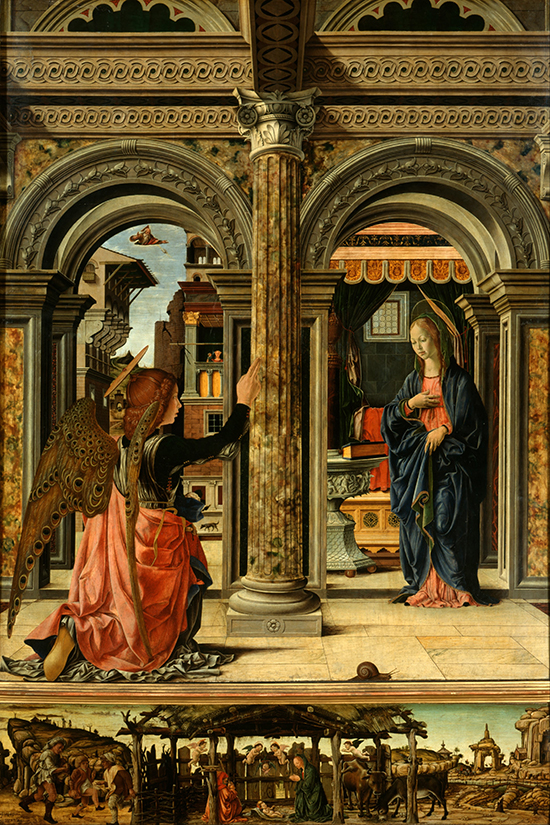
—...art of the Piazza—
– Annunciation
Francesco del Cossa
It is, in short, a difficult space to read. And there is more. The Annunciation sits atop a predella depicting an adoration of the shepherds, Mary is kneeling in devotion before her offspring, in a shelter that offers little in the way of actual shelter. It is open, porous, diaphanous almost; a space which lets angels flood in, shepherds peer through, the grace of the infant Christ, we must suppose, spill out. An enclosed space not enclosed.
Whatever tabernacle of secrets and mysteries energises the religious art of the fifteenth century Renaissance, in other words, is near-instantly flushed into the public domain. Carried into the street. It is an art, then, standing at one extreme of the interior-exterior axis. For its polar opposite, we must turn to an art of the interior, properly understood. And for art of the interior, you must head into the cold north.
![]()
Here, in the cold north, a snail is eating my hosta.
I say, my hosta, but I have only just this minute come into seigneurial possession of it. It is much more the snail’s hosta than my hosta. The snail is not eating my hosta: I am looking at a snail enjoying its hosta.
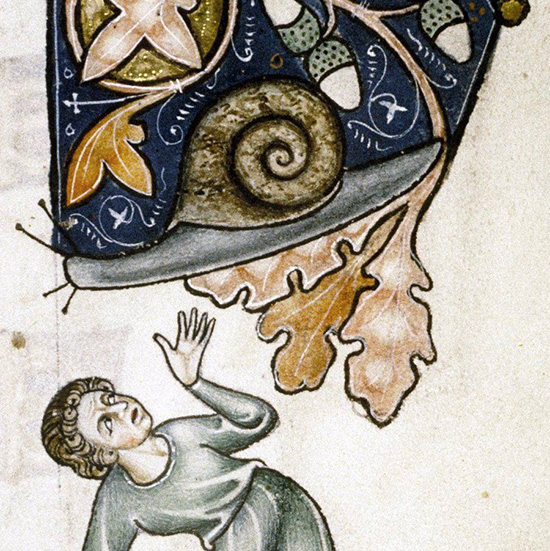
—...seigneurial possession—
– Ormesby Psalter
The hosta is in a pot, and the pot is in my new garden, standing just outside the kitchen door. It is not really a garden, but a little stone-flagged, dank, enclosed space. A space which could be said to face neither east, west, south or north. A space which faces only up. A space, that is, with very particular potential.
I am standing in the mouth of the kitchen door, looking out at this space, my rucksack still slung on one shoulder. Veronica di Viggiani comes and stands next to me. This is our new house, and we are just now moving in.
That snail, I say, indicating with a flick of the chin, will have to pack up its hosta and go.
![]()
If the art of the Italian Renaissance is an art of the crisis of the interior, the art of the North, of the Netherlands and then of the Dutch Republic, is an art of the interior longing for exteriors.
Let us select for consideration one example from among the interchangeable host of brown Dutch interiors inventoried on the walls of countless museums,an interior by Pieter de Hooch, painted in 1664 or 1665, hanging now in another sort of interior space, a room of the Kunsthistorisches Museum in Vienna.
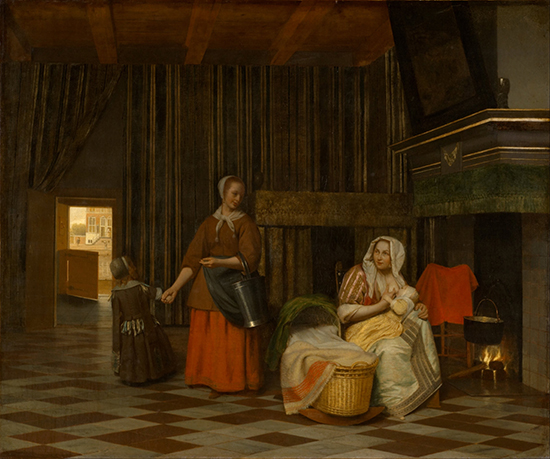
—...art of the interior longing for exteriors—
– Woman with Child and Serving Maid
Pieter de Hooch
Interchangeable? No. Each is singular, particular. Genre pieces perhaps, built to a formula of sorts; but then what are domestic interiors themselves if not variations of a genre, built to a formula? Each of us has stored and storied particular interiors, the interiors I suppose of our earliest childhoods, which operate talismanically, emblems reminding us that to be alive in the world is to particularise the generalities of culture, or of cosmic structure.
Thus in this particular de Hooch, a small child longs for the outside. The child wishes to go out and play in a greater world represented here by an open door, an interrupted rectangle of yellowish light, a view of a canal, a building and the reflection of a building, a walled garden with trees in leaf, neighbours passing on the far side or standing on elevated steps.
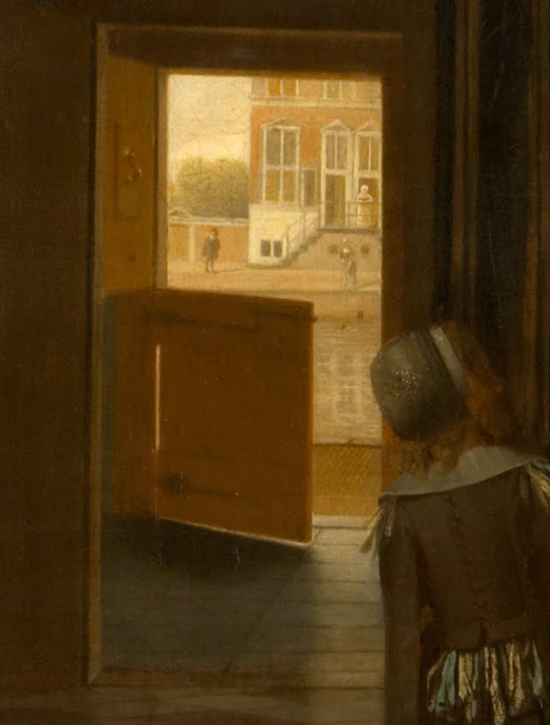
—...a greater world...—
– Woman with Child and Serving Maid, detail
Pieter de Hooch
We know instantly and instinctively what that promise of a world feels like. What it sounds and smells like. The tang of the foetid canal, the bark of a dog, the shouts of children playing, perhaps, in that walled garden. No wonder the child is eager to be out, and off. It is still attached – umbilically you might say, but in fact by the grip of a loving hand – to the secure presence of, not the mother, but a surrogate mother, the serving maid. But the security of the attachment is inversely indexed to the need to escape, and the umbilical connections of a little social group – family with servants – are complex. In this case, the connnection passes through the grip of the hand of the serving maid, to her eyes making friendly contact with the eyes of the nursing mother, to the baby swaddled in sunlight-yellow affixed to her breast. A line of energy across the front of the painting which connects the fire with the outdoors, the hearth with the spring or early summer sunshine.
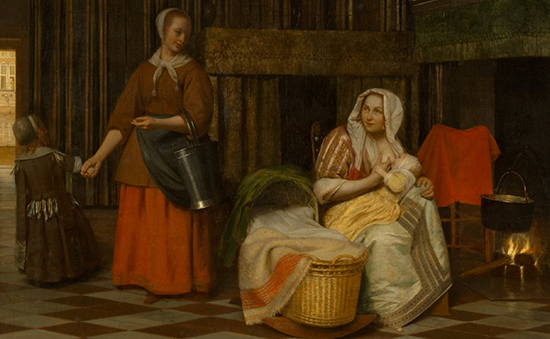
—...line of energy...—
– Woman with Child and Serving Maid, detail
Pieter de Hooch
There is no crisis of inner and outer here, of interior becoming exterior; there is only a delicate series of connections linking hearth to sun via harmonies of domestic balance, tending to the linear, the natural, like a river flowing to the sea.
![]()
Veronica di Viggiani comes and stands beside me and rests on the crook of my arm. She is eight months gone, and leans heavily. We look out into our little courtyard garden. She tuts at the snail when I point it out, says, those paving stones need a scrub. A power wash. Will we hire a power washer? Or will you get down on your hands and knees with a scrubbing brush?
The paving stones are covered in lichen or slick moss, the patina of snail slime built up over multiple snail generations. She is right. People will slip. Crack heads, bust ankles.
I tell her, I will hire a Dutch serving maid. It is the only way.

—...the only way—
– A Courtyard in Delft, detail
Pieter de Hooch
![]()
I say there is no crisis of interior and exterior in that de Hooch painting, of inner and outer, but perhaps I am wrong.
Is that child a boy or a girl, for example? At first glance, to us, a girl. But who knows how the Dutch dressed their infant children? I have a notion, a half-memory, that this is a boy.
In which case, there is a small crisis going on here. That boy is straining for the outer world, the public world, the world of men. The domestic interior is the domain of women and of children. There are houses in East Africa in which women live out their entire lives, exiting only at their death. That boy, when he finally breaks loose from the gentle grip of his nurse, the solicitous gaze of his mother, will go out that door and disappear.
![]()
And there are other crises, other axes available, beyond origin-dissolution, beyond inner-outer. There is upper-lower.
Follow the coil of the umbilicus down down down, and who knows what you will find, interred beneath the irregular geometry of those scrubbed red-and-white flagstones.
In the centre of Anatolia they have in recent years excavated a small Neolithic town, a town built exclusively of domestic interiors, of no public buildings, no public spaces, where beneath the earth floors lie promiscuously buried the bones of the ancestors. Çatalhöyük at its peak had a population of several thousand Neolithic souls living cheek by jowl. It numbers among the first settlements properly understood, the Neolithic being the point in history where the perpetually wandering early humans took root in a place, built houses, started farming, storing surpluses.
The houses at Çatalhöyük abutted one another; they were entered via a hole in the roof, down a ladder. The houses had clean and plastered interiors, but in many of the houses there are bones buried beneath the floor – typically, beneath the hearth, the beds, or a raised platform. Some of the skulls have themselves been plastered over, as if to reflesh them; they are painted in ochre. And in some houses there are a great many bones, the bones of many individuals. Archaeologists call these houses ‘history houses’. They were repositories for the bones of the ancestors.
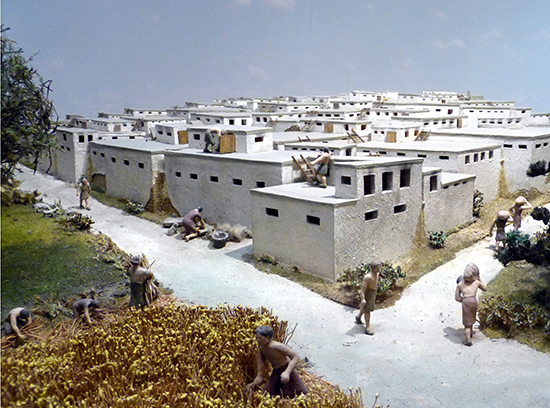
—...cheek by jowl.—
– Çatalhöyük, model
picture: Wolfgang Sauber, CC BY-SA 4.0, via Wikimedia Commons
Çatalhöyük depended for its livelihood not only on early farming and domestication of livestock but on the hunt, specifically on the hunt for the great aurochs of the plane. It was a society, evidently, that was riven with tension, the tension inherent in close, non-familiar (and familiar) co-habitation. Whereever the archaeologists dig, they find small fired clay balls, slingshot; and many of the bones and skulls they excavate from beneath the floor of the houses show slingshot-type injuries, many of which would have been fatal. Stand up on your roof on an Anatolian spring evening at your peril.
There was no obvious reason for people to live close-packed like this. They were not defending themselves from other groups, there does not seem to have been a coercive central power. There may have been self-perpetuating religious or ritual imperatives. In any case there they remained, for multiple generations, a little society warring itself on the plain, built on the bodies of the slain and the midden of past generations.
![]()
Elsewhere in the Neolithic, still-born children were sometimes buried beneath the floors of houses with their mothers, when the mothers had died in childbirth. At Lepenski Vir, alongside the Danube, there are numerous such burials, taken to be, not foundation rituals, but careful interments1.
One of the burials at Lepenski Vir is of a child accompanied with fifty perforated snail shells, and sprinked with carp teeth.
![]()
Who knows, then, what we would find under those red and white flagstones, if we dug deep enough. De Hooch has not painted a world in tension, but he has certainly painted in a world in tension, a commercial Dutch Republic at war with its rivals for the right to carry trade goods and slaves in support of empires, draining the wealth of continents.
Or perhaps we should follow the logic of the painting. All lines point to the umbilicus, the vanishing point. The lines of the ceiling beams, the mantlepiece, the delicate human line leading from hearth to doorway. All lines lead to the singularity.
Somewhere out there, then, in the centre of the town, there will be a plaster-white church interior built over the bones of the ancestors, a history house. The town church.
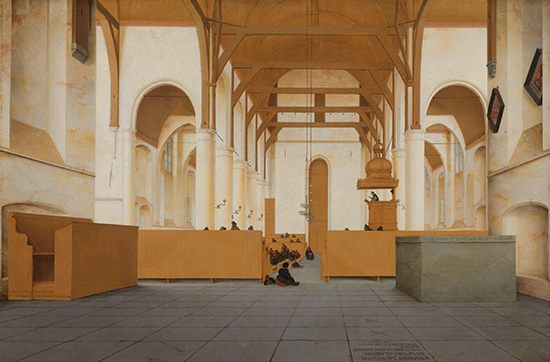
—...history house.—
– Interior of the Church of St. Odulphus at Assendelft
Pieter Jansz. Saenredam
![]()
And so as I stand there in our new house, regarding the snail, my arm around a pregnant Veronica di Viggiani, and theorise the umbilicus, deriving it from the logic of spatial and temporal intersection – it must be! – but the reality is, I am trying to account for something, a notion, a feeling, an awareness. That we sometimes find ourselves in the place we are supposed to be. An intuition, call it.
The umbilicus is an emotional point, after all; not a geometric one. It is the node of maternal connection and separation, blood and detachment. And it is hard to triangulate from an emotion.
There is a passage in The Teaching of Don Juan by Carlos Castañeda where Castañeda’s spiritual mentor – Don Juan – tells him that everyone can situate themselves at an intersection of energies which renders them stronger. And he leaves Castañeda to find his spot on a verandah in the house in which they are staying. Castañeda has no idea what he is supposed to do. He spends the whole night sitting, rolling, standing, squatting, on every square metre of the verandah; in the end, he falls asleep, squatting, and has a vision. This, it turns out, is his spot. He did not find it. It drew him in, like a vortex, a whorl, an umbilicus.
Or, it may be, there is no pre-ordained spot. You do not find the spot. You create it. The imagination is factive after all. Thus when I imagine the geo-social centre of the city of Norbiton, cross-referencing it with the geo-social data of my own life, I can extrapolate something – a dank flagstoned courtyard with snails and my pregnant wife. And from that something – call it, an umbilicus, an omphalus, a navel – we can extrapolate a life, or the life and history of an entire city. The unbilicus is not logically deduced, in other words; it is simply the origin of everything that comes after, but also that came before.
And I should complete this thought by noting, that a city does not, cannot, have one centre. A city is multiple, a gelatinous coherence of cells. A great snail, if you will.
![]()
If the gods of nomadic, pastoral people are housed in tabernacles, temples, churches, then the god of settled peoples lives in the sky, unhoused.
In Francesco del Cossa’s Annunciation, God the Father hangs in the Empyrean, loosing his holy spirit like a plump arrow.

—...plump arrow.—
– Annunciation, detail
Francesco del Cossa
And, as if to balance the Creator's rootlessness, making its way across the ceiling of the subterranean predella, is a snail.

—...to balance the Creator's rootlessness.—
– Annunciation, detail
Francesco del Cossa
God the father and lowly snail are the same form, and the same size. One, the origin of all space and time; the other, just a snail. Which is aping which? Is God the Father delighting in the close-knit form of his creation? Or do God's created beings in mimicry create their creator?
I do not know. But it is worth noting that the shells of many species of snail are coiled around a central whorl, axially-aligned, known as an umbilicus. Wells of complexity, easily capable of throwing up such simple indivisible entities as mere gods.
I put down my pack, kiss Veronica on the cheek, and, uncoiling my train of thought, say, in response to no question, yes, here.
